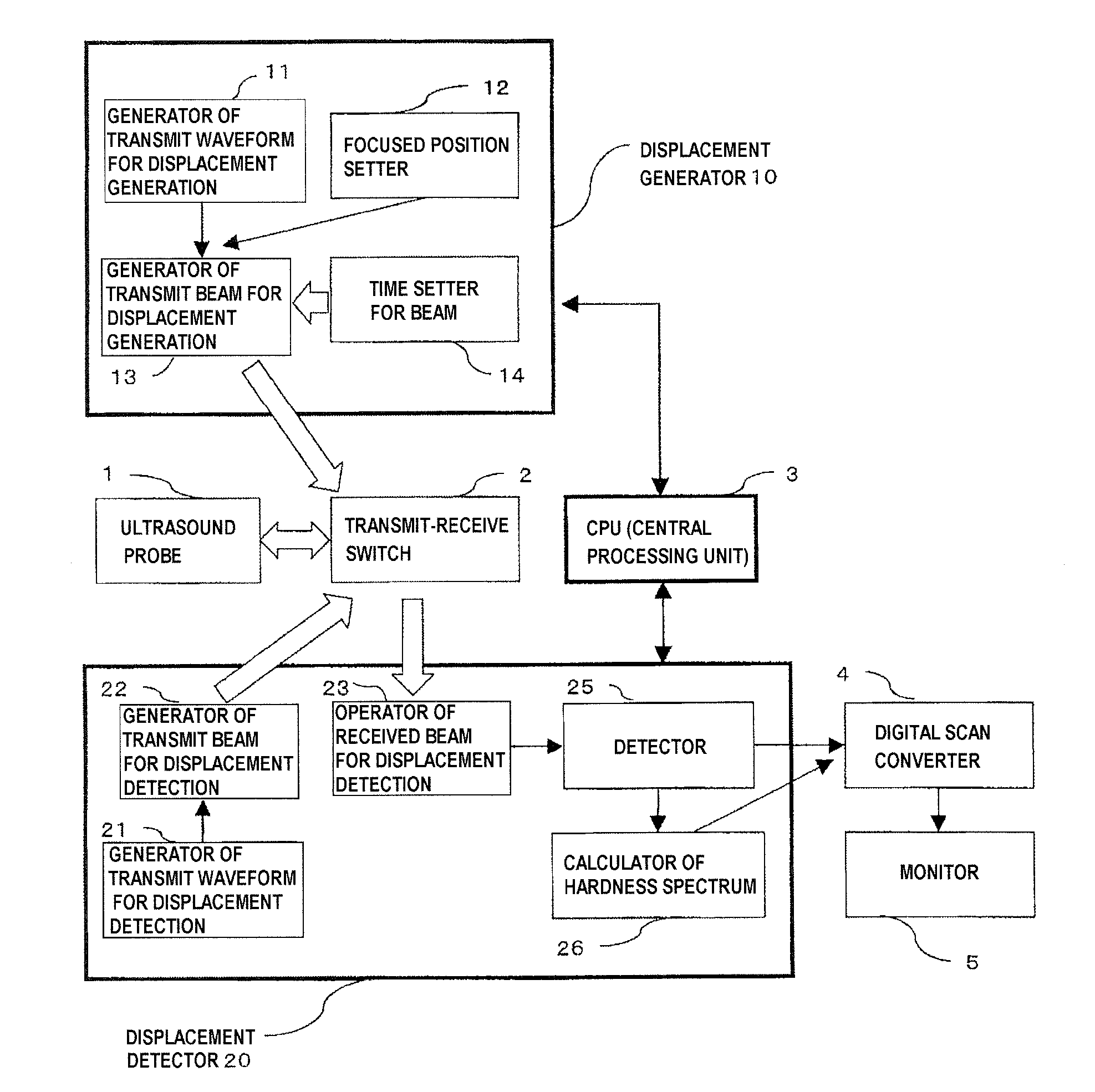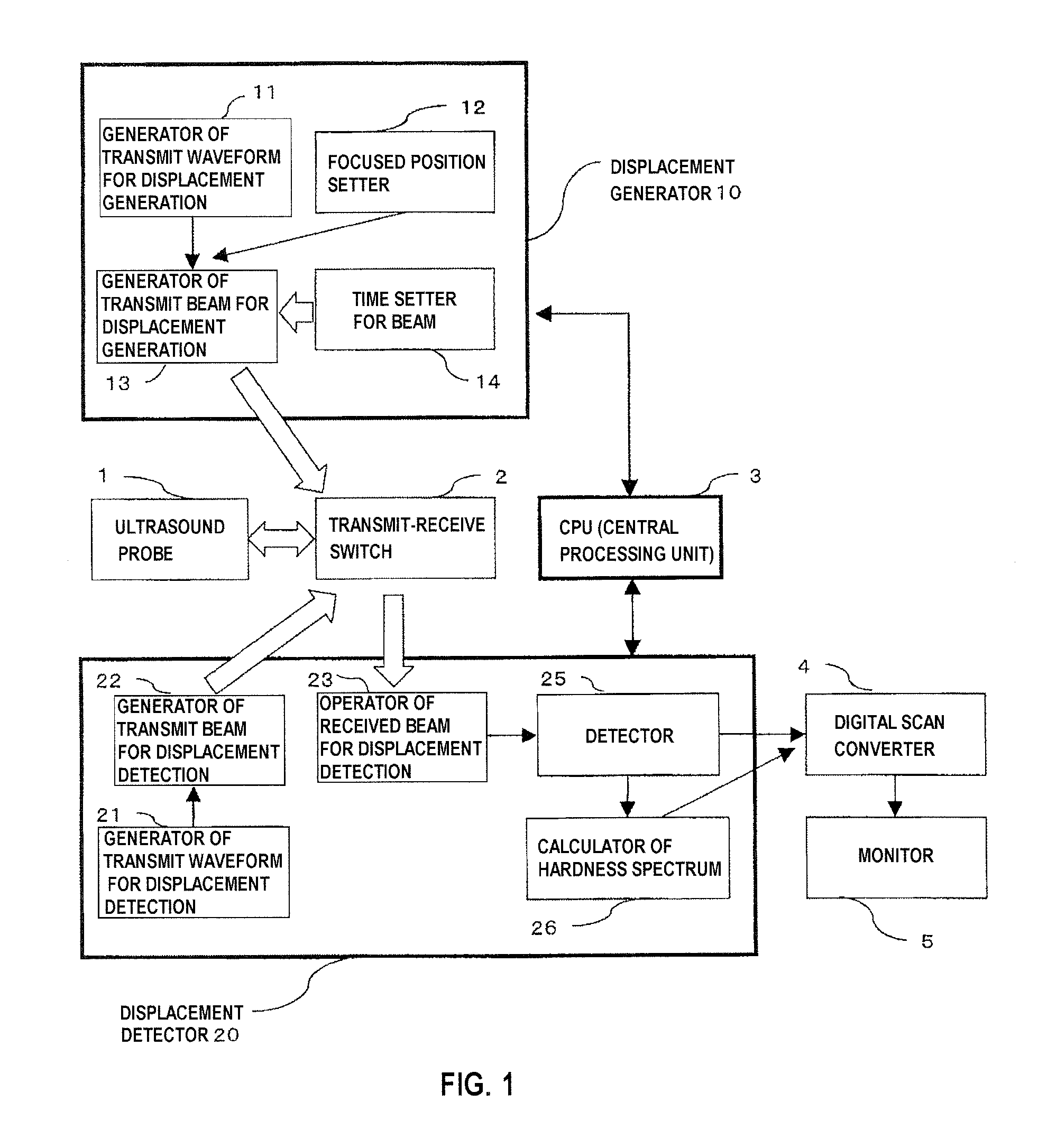Ultrasonic diagnostic device
a diagnostic device and ultrasonic technology, applied in tomography, instruments, applications, etc., can solve the problems of difficult to calculate the hardness inside the liver by elastography, difficult to exert compression enough to cause liver displacement, and limited imaging targets, etc., to improve the accuracy of diagnosis. , the effect of improving the transmission sensitivity
- Summary
- Abstract
- Description
- Claims
- Application Information
AI Technical Summary
Benefits of technology
Problems solved by technology
Method used
Image
Examples
first embodiment
[0040]In the first embodiment, as shown in FIG. 2, an explanation will be made as to the case where a linear array type ultrasound probe 1 is used, being brought into contact with the body surface of a test object, and the ultrasound beam for displacement generation (hereinafter, also described as a focused beam) is focused onto two focused points. The two focused points are respectively positioned on two different rasters (scanning lines) on a target cross-sectional surface within the body, and they are located at the same depth from the body surface. As shown in FIG. 3, a distance between each of the focused points and each device 100 of the ultrasound probe 1 is obtained, and a difference of the distance with respect to each device is divided by a sound velocity of the target object so as to calculate a delay time, and the generator of transmit beam for displacement generation 13 performs transmission of the transmit signal that is provided with the delay time, thereby achieving ...
second embodiment
[0096]In the second embodiment, the switching period of the time duration of beam exposure for exposing one focused point out of the two focused points is kept constant, and only the switching period of the time duration of beam exposure for exposing the other focused point is changed. In other words, this relates to a method for sweeping the phase.
[0097]With reference to FIG. 12, the second embodiment will be explained. As indicated by the sequence of the focused beam shown in FIG. 12, the time width of the focused beam when the focused point F1 is ON and the time width of the focused beam when the focused point F2 is ON are assumed as Ta (fixed). In addition, it is controlled so that a value of the time width Tm from the time when the focused beam directed to the focused point F1 becomes ON to the time when the focused beam directed to the focused point F2 becomes ON is made gradually smaller by a constant interval ΔT, such as from T1(=Tstart=Ta), T2, T3, and so on. With the metho...
third embodiment
[0100]In the present embodiment, an explanation will be made as to the measurement that is conducted with focusing on multiple points, in order to diagnose the hardness on a measurement site two-dimensionally. FIG. 14 illustrates directions of the focused beam exposure when the measurement is conducted at eight focused points F1, F2, F3, F4, F5, F6, F7, and F8 on a concentric circle, and propagation directions of shear waves that are produced along with the exposure. In the present embodiment, the number of the focused points is set to be eight, but the number of the focused points is not limited to this number. FIG. 14(a), (b), and (c) illustrate variations of a pair of two focused points. By way of example, FIG. 14(a) illustrates that neighboring points, that is, the focused point F1 pairs with the focused point F2, the focused point F2 pairs with the focused point F3, the focused point F3 pairs with the focused point F4, and so on. Measurement of those pairs is particularly effec...
PUM
 Login to View More
Login to View More Abstract
Description
Claims
Application Information
 Login to View More
Login to View More - R&D
- Intellectual Property
- Life Sciences
- Materials
- Tech Scout
- Unparalleled Data Quality
- Higher Quality Content
- 60% Fewer Hallucinations
Browse by: Latest US Patents, China's latest patents, Technical Efficacy Thesaurus, Application Domain, Technology Topic, Popular Technical Reports.
© 2025 PatSnap. All rights reserved.Legal|Privacy policy|Modern Slavery Act Transparency Statement|Sitemap|About US| Contact US: help@patsnap.com



